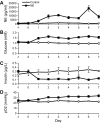Enhanced insulin secretion responsiveness and islet adrenergic desensitization after chronic norepinephrine suppression is discontinued in fetal sheep
- PMID: 24253046
- PMCID: PMC3920003
- DOI: 10.1152/ajpendo.00517.2013
Enhanced insulin secretion responsiveness and islet adrenergic desensitization after chronic norepinephrine suppression is discontinued in fetal sheep
Abstract
Intrauterine growth-restricted (IUGR) fetuses experience prolonged hypoxemia, hypoglycemia, and elevated norepinephrine (NE) concentrations, resulting in hypoinsulinemia and β-cell dysfunction. Previously, we showed that acute adrenergic blockade revealed enhanced insulin secretion responsiveness in the IUGR fetus. To determine whether chronic exposure to NE alone enhances β-cell responsiveness afterward, we continuously infused NE into fetal sheep for 7 days and, after terminating the infusion, evaluated glucose-stimulated insulin secretion (GSIS) and glucose-potentiated arginine-induced insulin secretion (GPAIS). During treatment, NE-infused fetuses had greater (P < 0.05) plasma NE concentrations and exhibited hyperglycemia (P < 0.01) and hypoinsulinemia (P < 0.01) compared with controls. GSIS during the NE infusion was also reduced (P < 0.05) compared with pretreatment values. GSIS and GPAIS were approximately fourfold greater (P < 0.01) in NE fetuses 3 h after the 7 days that NE infusion was discontinued compared with age-matched controls or pretreatment GSIS and GPAIS values of NE fetuses. In isolated pancreatic islets from NE fetuses, mRNA concentrations of adrenergic receptor isoforms (α1D, α2A, α2C, and β1), G protein subunit-αi-2, and uncoupling protein 2 were lower (P < 0.05) compared with controls, but β-cell regulatory genes were not different. Our findings indicate that chronic exposure to elevated NE persistently suppresses insulin secretion. After removal, NE fetuses demonstrated a compensatory enhancement in insulin secretion that was associated with adrenergic desensitization and greater stimulus-secretion coupling in pancreatic islets.
Keywords: adrenergic receptor; catecholamines; intrauterine growth restriction; uncoupling protein 2; β-cell.
Figures




Similar articles
-
Islet adaptations in fetal sheep persist following chronic exposure to high norepinephrine.J Endocrinol. 2017 Feb;232(2):285-295. doi: 10.1530/JOE-16-0445. Epub 2016 Nov 25. J Endocrinol. 2017. PMID: 27888197 Free PMC article.
-
Chronic exposure to elevated norepinephrine suppresses insulin secretion in fetal sheep with placental insufficiency and intrauterine growth restriction.Am J Physiol Endocrinol Metab. 2010 Apr;298(4):E770-8. doi: 10.1152/ajpendo.00494.2009. Epub 2010 Jan 19. Am J Physiol Endocrinol Metab. 2010. PMID: 20086198 Free PMC article.
-
Chronic Adrenergic Signaling Causes Abnormal RNA Expression of Proliferative Genes in Fetal Sheep Islets.Endocrinology. 2018 Oct 1;159(10):3565-3578. doi: 10.1210/en.2018-00540. Endocrinology. 2018. PMID: 30124804 Free PMC article.
-
Fetal adaptations in insulin secretion result from high catecholamines during placental insufficiency.J Physiol. 2017 Aug 1;595(15):5103-5113. doi: 10.1113/JP273324. Epub 2017 May 26. J Physiol. 2017. PMID: 28194805 Free PMC article. Review.
-
Catecholamines mediate multiple fetal adaptations during placental insufficiency that contribute to intrauterine growth restriction: lessons from hyperthermic sheep.J Pregnancy. 2011;2011:740408. doi: 10.1155/2011/740408. Epub 2011 May 11. J Pregnancy. 2011. PMID: 21773031 Free PMC article. Review.
Cited by
-
Chronic Epinephrine-Induced Endoplasmic Reticulum and Oxidative Stress Impairs Pancreatic β-Cells Function and Fate.Int J Mol Sci. 2024 Jun 27;25(13):7029. doi: 10.3390/ijms25137029. Int J Mol Sci. 2024. PMID: 39000139 Free PMC article.
-
RNA Sequencing Exposes Adaptive and Immune Responses to Intrauterine Growth Restriction in Fetal Sheep Islets.Endocrinology. 2017 Apr 1;158(4):743-755. doi: 10.1210/en.2016-1901. Endocrinology. 2017. PMID: 28200173 Free PMC article.
-
Fetoplacental oxygen homeostasis in pregnancies with maternal diabetes mellitus and obesity.Nat Rev Endocrinol. 2022 Oct;18(10):593-607. doi: 10.1038/s41574-022-00717-z. Epub 2022 Jul 28. Nat Rev Endocrinol. 2022. PMID: 35902735 Review.
-
ASAS-SSR Triennnial Reproduction Symposium: Looking Back and Moving Forward-How Reproductive Physiology has Evolved: Fetal origins of impaired muscle growth and metabolic dysfunction: Lessons from the heat-stressed pregnant ewe.J Anim Sci. 2018 Jun 29;96(7):2987-3002. doi: 10.1093/jas/sky164. J Anim Sci. 2018. PMID: 29701769 Free PMC article. Review.
-
Daily injection of the β2 adrenergic agonist clenbuterol improved poor muscle growth and body composition in lambs following heat stress-induced intrauterine growth restriction.Front Physiol. 2023 Sep 6;14:1252508. doi: 10.3389/fphys.2023.1252508. eCollection 2023. Front Physiol. 2023. PMID: 37745251 Free PMC article.
References
-
- Aldoretta PW, Carver TD, Hay WW., Jr. Maturation of glucose-stimulated insulin secretion in fetal sheep. Biol Neonate 73: 375–386, 1998 - PubMed
-
- Ashcroft FM. Adenosine 5′-triphosphate-sensitive potassium channels. Annu Rev Neurosci 11: 97–118, 1988 - PubMed
-
- Bassett JM, Hanson C. Catecholamines inhibit growth in fetal sheep in the absence of hypoxemia. Am J Physiol Regul Integr Comp Physiol 274: R1536–R1545, 1998 - PubMed
-
- Bell AW, Wilkening RB, Meschia G. Some aspects of placental function in chronically heat-stressed ewes. J Dev Physiol 9: 17–29, 1987 - PubMed
-
- Benovic JL, Onorato JJ, Caron MG, Lefkowitz RJ. Regulation of G protein-coupled receptors by agonist-dependent phosphorylation. Soc Gen Physiol Ser 45: 87–103, 1990 - PubMed
Publication types
MeSH terms
Substances
Grants and funding
LinkOut - more resources
Full Text Sources
Other Literature Sources
Medical

